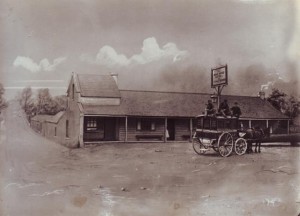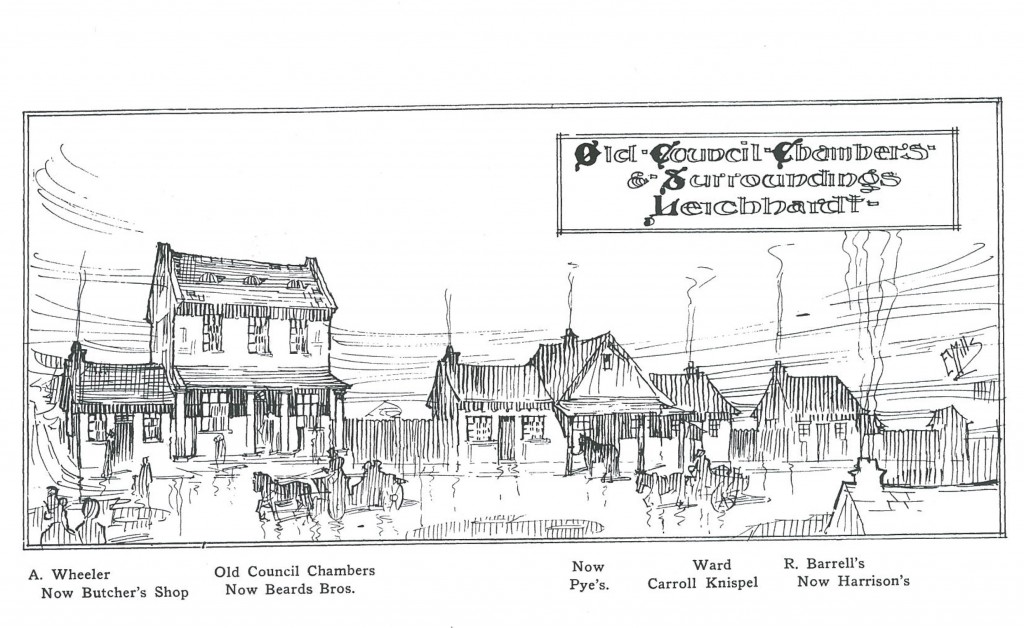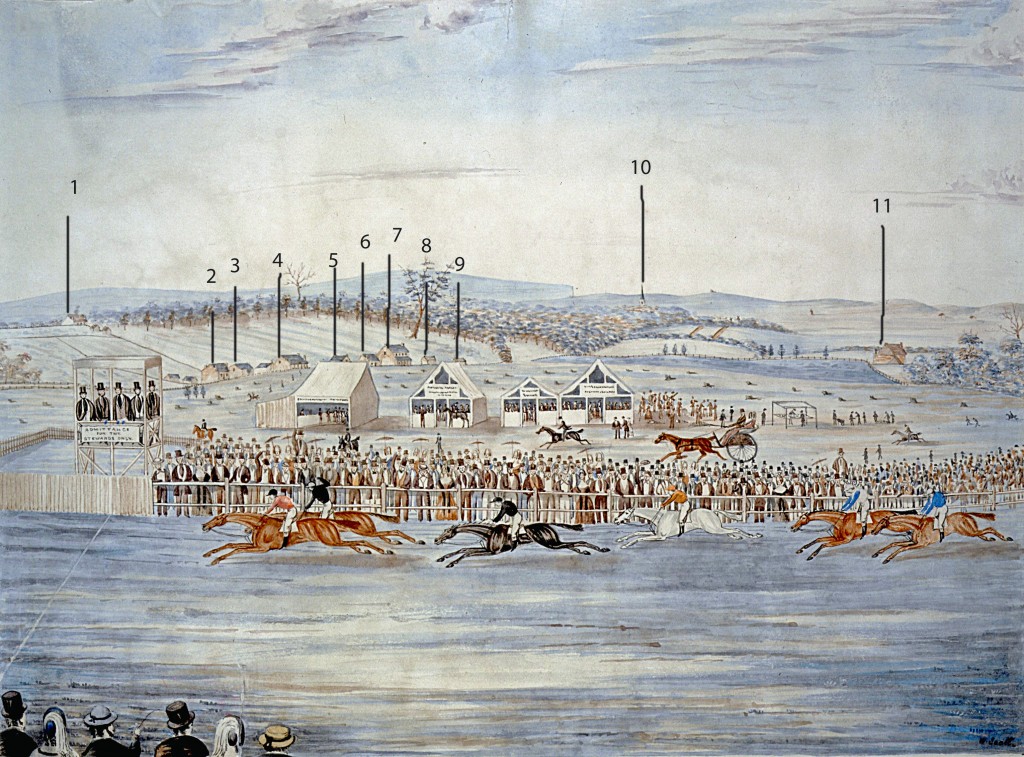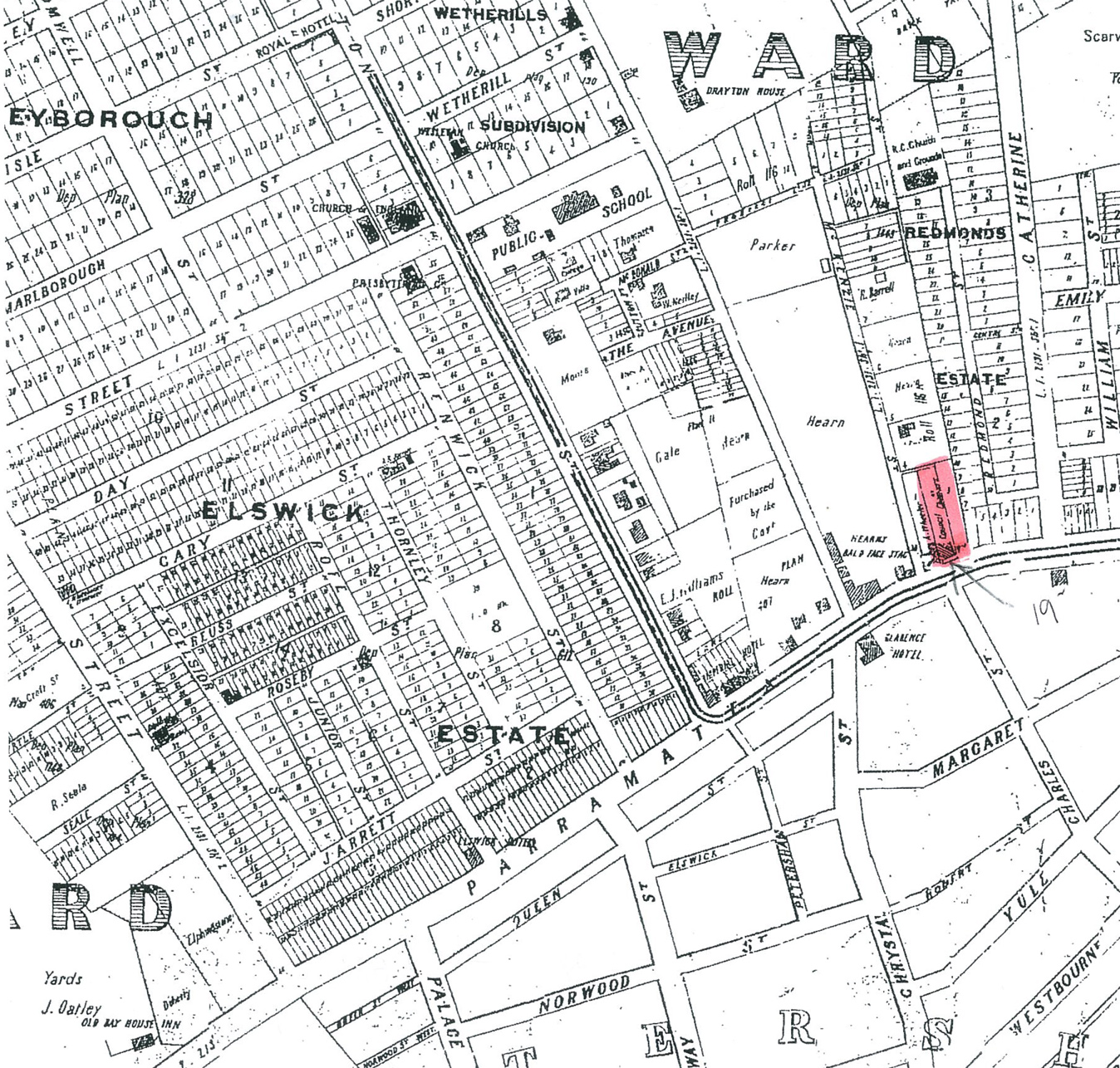The Bald Faced Stag hotel was built in the early 1830s by Abraham Hearn on the corner of Parramatta Road and Balmain Road. The pediment on the current hotel implies that it was named the Bald Faced Stag from its inception. However in the early years it may have been known by several different names. By 1843, still owned by Hearn, it had become the Woolpack Inn with Thomas Shaw as licensee. A cluster of early pubs appeared in this stretch of road, as it was an overnight stopping point for the first days journey of bullock teams from Sydney to Parramatta and where mail coaches made their first and last stop. When the railway was built in the 1850’s the stage coach and bullock team traffic declined.

Original Bald Faced Stag one of Sydney’s Earliest Pubs c1830 Corner of Balmain Road and Parramatta Road. (the first Woolpack Inn.)
In about 1843, and until 1850 the entrepreneurial Thomas Shaw conducted a racecourse on land leased on the other side of Parramatta Road, extending towards the present railway line and with a grandstand in present Railway Street (about where the Tongan Uniting Church now stands). Race meetings were patronised by the sports fans of Sydney paying from 2s 6d to one guinea (21s) to attend, and they only permitted entrance was, of course a gate opposite the Woolpack/Stag. The course was small with tight bends but on occasion it was said that up-to 10,000 people attended -about 20% of Sydney’s population at the time. (1)
John Thomas Hamilton Hill, the son of Francis Hill (Shaw) was born in 1869, and lived for 24 years in a house next door to the Council Chambers (Woolpack Inn). When he died in 1945, he left in his will that this painting, by W. Scott of the racecourse in 1845, be given to the Mitchell Library. His description of the buildings in his own handwriting was included with the painting.
This painting was also used as a backdrop to the opening credits in the ABC documentary, Rogue Nation, written by Michael Cathcart in 2009, covering the first 40 years of the colony’s history.
Buildings reading from left to right.
1. Two cottages, Prospect and Hay Street corner. R Parker owner and occupier, Captain Whitney owner and occupier
2. Abraham Hearn owner.
3. Abraham Hearn owner and occupier.
4. The Woolpack Inn, lessee Thomas Shaw owner Abraham Hearn.
5. Robert Barrell, storekeeper, owner occupier (Alderman on first Petersham Council).
6. Charles Hughes owner.(To be transferred to Nicholas & Harriett Newnham in 1847).
7. House just erected. Built for a hotel, and opened in 1847 as the Woolpack Inn.
The name being transferred from the older one, when Shaw’s license expired. – Charles Hughes owner and licensee.
8. Cottage especially built for, and occupied by police constable. – Charles Hughes owner.
9. Occupier Mr. Tranter.
10. Unidentified church.
11. Johnstone Family mansion.
In 1846 Thomas Shaw & Abraham Hearn parted company. Shaw spent 1847 running the Starr Inn in Parramatta. Previously in 1844 Thomas Shaw’s father – in – law, Charles Hughes along with his wife Sarah (Peyton) purchased three blocks of land on the corner of Hay Street. (First called Piper then MacKenzie Street) He then signed over lot 1 the first block on the corner of Hay Street to his newly married daughter Harriett and her husband Nicholas Newnham. (2) (There is one account which says the first brick house on Parrmatta Road was standing on this site and was occupied for some time by Mr. Tavener a large land owner (3). On previous records Charles had been described as a butter merchant, but on this document he is described as a victualler. Nicholas is described as brewer, which he was at the Kent Brewery. (His brother having entered into partnership with the Tooth Bros.) Then Charles Hughes commissioned a larger family home for the second block, and apparently this was constructed by son-in-law Thomas Shaw who was also a carpenter/builder. So by 1847 the name Woolpack was transferred to this new public house with Charles as licensee, situated 100 metres closer to Sydney than the original Woolpack Inn. This probably required Abraham Hearn to re name his hotel the Bald Faced Stag.
Charles died in 1848 having appointed Nicholas as his executor. The following year 1849, Sarah Hughes remarried and her new husband, Robert Oliver became the licensee of the Woolpack Inn, which he retained until 1854. In 1855 Harriett and Nicholas decided to sell their property to William Henry White for 850 pounds (4). In 1869 this property was sold by White to Aaron Wheeler, who was for some time the toll keeper at the Johnston Creek toll gate and along with the others instrumental in establishing the Leichhardt Municipality in 1871 (5).
The last recorded entry of Sarah Hughes’s Woolpack Inn was in the 1867 edition of Sands Directory. Sarah died in 1868, Nicholas Newman as the executor of Sarah’s will, sold Lots 2 & 3 and all their buildings to Henry McNamara in 1870 for £550.(6)
Henry McNamara was an alderman on the first Petersham Council which was established in 1872. Early maps show the site of the first Leichhardt Council and Working Man’s Institute, to be on Lot 2. Aformer public house would be an ideal site for a Working Man’s Institute as their principal activity was as a billiard saloon. The first meeting of Leichhardt Council met in 1872 at the Working Man’s institute, it is possible that it was one building serving two purposes. (7)
By combining Sands and the rate books the occupants of the properties from Hay Street to Catherine Street in 1872 were: Aaron Wheeler – cottage 6 rooms, Leichhardt Council, the Working Man’s institute, Henry McNamara’s – House 11 rooms and stables, John Thomas Ireland, Thomas Shaw, carpenter. There is no indication of how many buildings were actually involved. It may be that 11 rooms plus eleven out houses actually housed Thomas Shaw and his family, John Ireland, The Working Man’s Institute and the Council Chambers. This proposition is supported by two sources. Firstly the Redmond Estate was not subdivided and sold off until 1880. In 1872 the blocks of the estate on Parramatta Road were only paddocks.
Secondly, the following is an account, written in the 1870s about traveling into Leichhardt from Sydney ” Just past White’s Creek was a road leading to the abattoirs, this being known as Bullock Road, (now Catherine Street), a place in those days of considerable risk to pass on market days by reason of the mobs of cattle being there driven. A few yards beyond here, still on Parramatta Road-were two buildings, one of them occupied as the Leichhardt Council Chambers, the other at the corner of what is now known as Hay Street, being the resident of Aaron Wheeler. A few yards further west at the corner of Balmain Road, was the Bald Faced Stag Hotel owned and occupied for many years by Mr Charles Hearn, who afterwards became one of the earliest Alderman of the Municipality” (8)
Leichhardt Council Chambers remained at this site until 1888 when a new Town Hall was erected at the corner of Norton and Marion Streets. In 1854, the same year that Robert Oliver relinquished the lease of the Woolpack Inn to Vincent Howell. Henry Hughes, the eldest son of Charles and Sarah Hughes had purchased land in the Wardeville Estate, on the opposite side of Parramatta Road, about 50 metres further east than the Woolpack Inn. (9) He built the Petersham Inn, in 1860 and for some years both hotels, owned by members of the same family, operated on opposite sides of the road to each other, until the Woolpack Inn finally closed in 1867. As well as owning the Petersham Inn, Henry Hughes was the licensee, almost every year from 1866 to 1880. Although he had many business interests including brick-making and land speculation, he also found time to be an alderman on the Petersham council from its inception in 1872 until 1894. He died in 1897.
Parramatta Road was redeveloped around 1937, at which time the original Petersham Inn was demolished and replaced by a new two storey hotel slightly further east on the corner of the newly opened Phillip Street, where it stands today. The small street behind it memorializes the Hughes name. (10)
This account of the two Woolpack Inns was compiled from the following references by Ron and Milton Hill (Great grandsons of Thomas Shaw and from family history records originally researched by Olga Newton and Jess Hill (Great grand Daughters of Thomas Shaw) and with the assistance of the following references. )
We also acknowledge the contribution of Don Hughes(Great Great Grandson of Charles Hughes) and his family history.
Any further historical information which adds to this story would be appreciated. Please contact Milton Hill at j_m_hill@tpg.com.au
(1) Marrickville People & places- Meander, Cashman & Carolan.
(2,4,6,8 & 9) Lands Department- Old Title Indentures, Conveyances.
(3, 5, 7 & 9) The Jubilee history of Leichhardt – A Vialoux & C.M Reeves
(10) C. Meander (1985) Pubs – heritage Vol. 2, Nov.pp11
Maps:
Image:
Bald Face Stag Link to Article
For a complete copy of this study please contact Local History at Leichhardt Library localhistory@innerwest.nsw.gov.au



